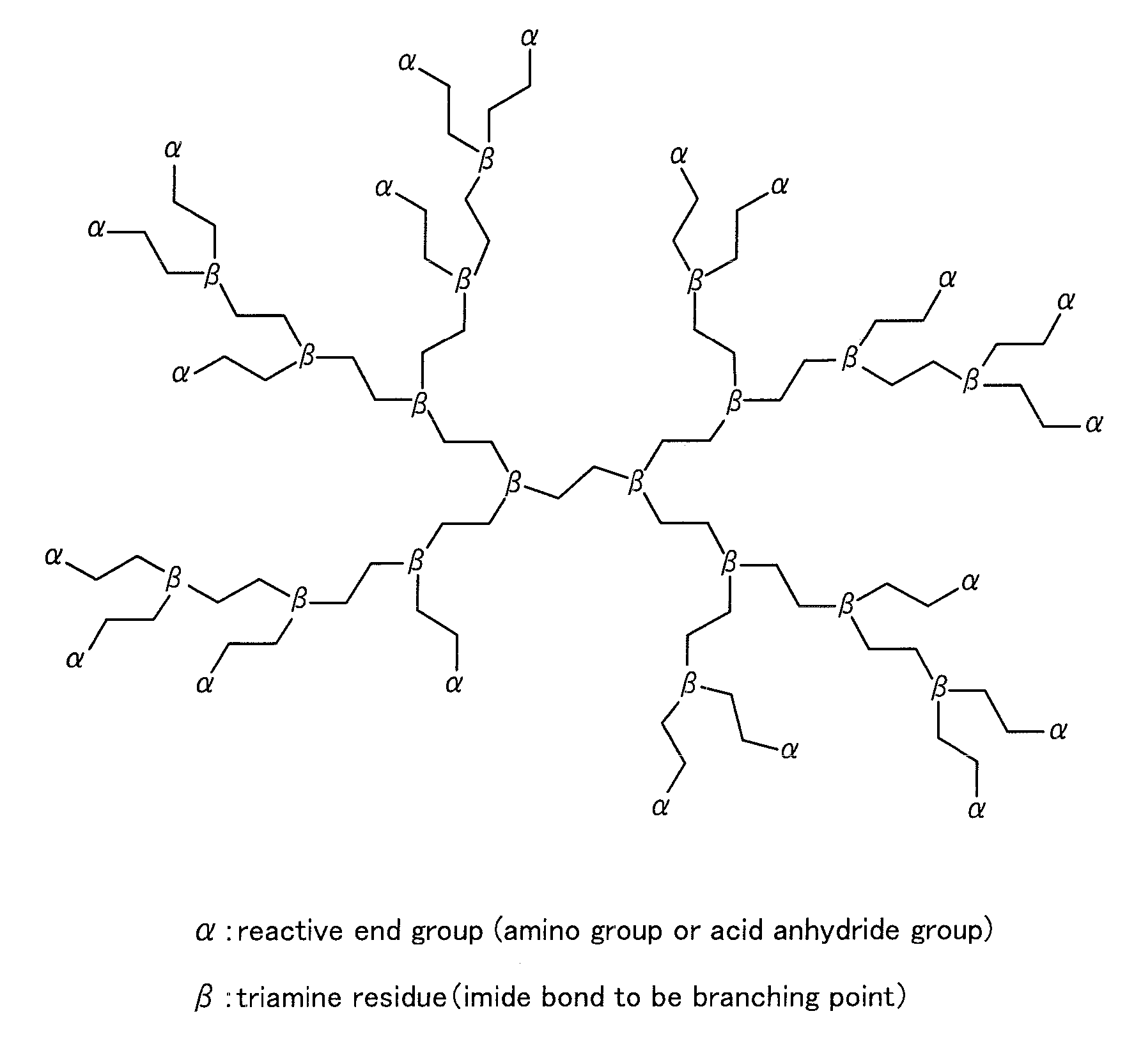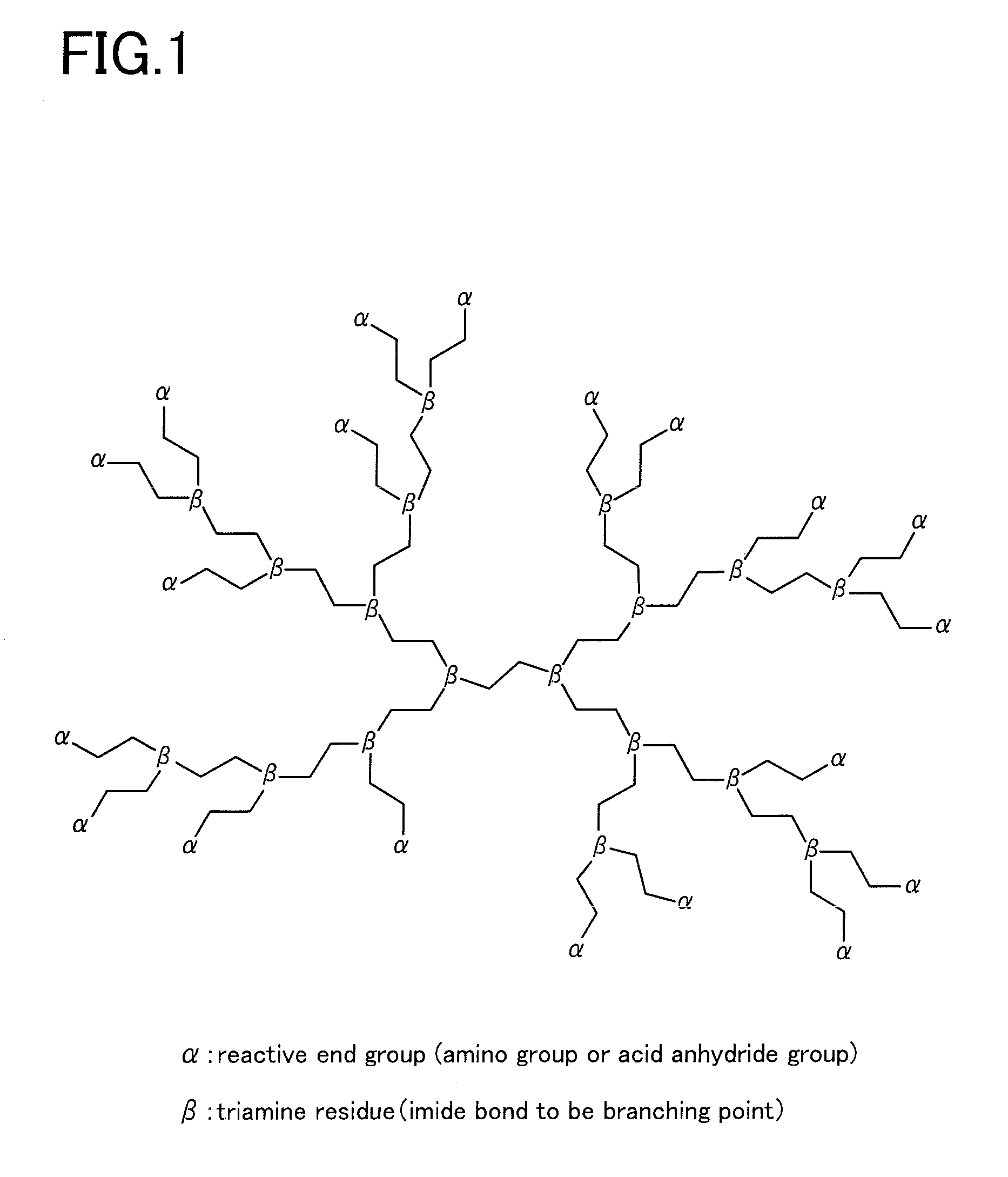Siloxane-modified hyperbranched polyimide
a polyimide and siloxane technology, applied in the direction of layered products, chemistry apparatus and processes, synthetic resin layered products, etc., can solve the problems that conventional siloxane-containing polyimides containing such a linear polyimide are difficult to modify with various functional groups, and achieve excellent electric properties (low dielectric properties), excellent mechanical strength and chemical resistance, and excellent mechanical properties.
- Summary
- Abstract
- Description
- Claims
- Application Information
AI Technical Summary
Benefits of technology
Problems solved by technology
Method used
Image
Examples
example 1
[0044] 0.898 g of 1,3,5-tris (4-aminophenoxy)benzene (TAPOB) and 0.062 g of bis(γ-aminopropyl)polydimethyl siloxane (PSX; in Example 1, one having an amine equivalent of 130 (PSX-130) was used) were put into a 100-ml four-necked flask equipped with a stirrer, a nitrogen-introducing tube filled with calcium chloride and a thermometer; and 35 mL of a co solvent of dimethyl acetamide (DMAc) and diethylene glycol dimethyl ether (diglyme, DIG) (DMAc / DIG=50 vol. %:50 vol. %—hereinafter this may be referred to simply as co solvent) was added thereto and dissolved. With the solution kept stirred, a solution prepared by dissolving 0.775 g of oxydiphthalic dianhydride (ODPA) in 35 mL of co solvent was gradually added thereto under a temperature condition of 25° C., and then stirred at 25° C. for 3 hours to react them, thereby a siloxane-modified hyperbranched polyamic acid was synthesized.
[0045] The obtained solution of siloxane-modified hyperbranched polyamic acid was cast onto a polyester ...
example 2
[0048] A solution of a siloxane-modified hyperbranched polyamic acid was obtained in the same manner as in Example 1, except for that, 0.180 g of PSX (PSX-360) having an amine equivalent of 360 was used as the aromatic triamine. 0.92 g of heptafluorobutyric anhydride (7FBA) was added to the solution, followed by stirring at 25° C. for 2 hours, whereby there was obtained a solution of a siloxane-modified hyperbranched polyamic acid whose ends were modified with a fluorine-containing compound. The obtained solution was dried and followed by an application of a heat treatment in the same manner as in Example 1, whereby a polymer was obtained. The obtained polymer contained 6.6 wt % of siloxane, evaluated in terms of siloxane.
[0049] FT-IR measurement was conducted for the obtained polymer, and like in Example 1, there were characteristic absorption bands which is attributed to a carbonyl group of polyimide and which is derived from a silanol bond, and in addition, there were characteri...
examples 3 to 7
[0051] Five kinds of polymers were obtained in the same manner as in Example 1, except for that, any of PSX-130, PSX-360, or PSX (PSX-460) having an amine equivalent of 460 was used as the diaminosiloxane compound in the amount indicated in Table 1, and the amount of TAPOB to be used was varied in accordance with the type and the amount of PSX used. The used amount of each compound is shown in Table 1.
[0052] FT-IR measurement was conducted for these five polymers, and the same results as in Example 1 were obtained. Accordingly, the obtained polymers were all siloxane-modified hyperbranched polyimides. In addition, also like in Example 1, the characteristics of the obtained polymers were investigated. The results are shown in Table 2.
PUM
| Property | Measurement | Unit |
|---|---|---|
| temperature | aaaaa | aaaaa |
| temperature | aaaaa | aaaaa |
| temperature | aaaaa | aaaaa |
Abstract
Description
Claims
Application Information
 Login to View More
Login to View More - R&D
- Intellectual Property
- Life Sciences
- Materials
- Tech Scout
- Unparalleled Data Quality
- Higher Quality Content
- 60% Fewer Hallucinations
Browse by: Latest US Patents, China's latest patents, Technical Efficacy Thesaurus, Application Domain, Technology Topic, Popular Technical Reports.
© 2025 PatSnap. All rights reserved.Legal|Privacy policy|Modern Slavery Act Transparency Statement|Sitemap|About US| Contact US: help@patsnap.com



